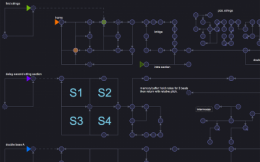Music created using the Nodal software
The days of sitting at keyboard with a pencil and a sheet of manuscript paper to compose music could be long gone with the development of software by researchers from Monash University’s Faculty of Information and Technology and Faculty of Arts.
Starting as an idea to develop a new way to create music by a team of researchers and musicians from the Centre for Electronic Media Art (CEMA), the resultant software is giving professional musicians and novices alike new ways of exploring music creation and performance.
Nodal, as it has been christened, is generative software for composing music, interactive real-time improvisation, and a musical tool for experimentation and fun.
Associate Professor Jon McCormack, Co-Director of CEMA said that Nodal was unlike any other music production tool.
“Nodal uses a unique visual representation which allows the composer to edit and interact with the music generation process as the composition plays,” Associate Professor McCormack said.
“It can be a serious composing tool for the professional musician or a fun application for school students to use as part of their music curriculum.”
Nodal is based around the concept of a user-created network, similar to a metropolitan transport system or connection of busy streets into traffic routes. The network consists of nodes (musical events) and edges (connections between events). Clusters of graphical nodes represent musical structure, in other words a piece of music.
Within the network the composer creates, ‘virtual players’ generate musical patterns by moving over the geometric structure, which defines pitch, rhythm, and sequence.
Nodal’s innovation is to create a clear connection between visual and musical organisation, making it intuitive for musicians to explore rich, emergent structures in their music.
“Musicians are able to change their compositions while the program is playing,” Associate Professor McCormack said.
“It is great for improvisation, quickly creating new musical ideas and thinking about musical structure in unconventional ways.”
The software was launched on Apple’s App Store in May and quickly shot to number two in sales in the music category – an indication of the interest generated by this revolutionary composing tool.
While the musical possibilities of Nodal are complex, it is very easy to use making it ideal for all ages, regardless of musical experience or ability. And with its built-in synthesiser and compatibility with any MIDI compatible hardware or software instrument, it is ideal for educational environments.
Currently Nodal is being implemented with great success into the music programs of the Scoula Media Statale Augusto and the Università di Napoli "Federico II” in Italy, Georgia State and California State Universities in the USA, and most recently by the John Monash Science School in Melbourne, who will use it as part of a new ‘generative arts’ subject this semester.
“All the institutions are finding the use of the Nodal is enhancing their music curriculum,” Associate Professor McCormack said.
“Students enjoy the experimentation possible with this new way of writing music. And the results often surprise and delight them, leading them to explore the possibilities more deeply.”
While the initial outcome of the project was to develop a new method of writing music, the technology has allowed for the team to investigate broader ‘musical’ phenomena found in nature, such as the syncopated beating of insects’ wings to attract mates.
But the most gratifying results for the software’s developers have been the feedback from musicians.
“A number of people have written to us, saying Nodal has completely changed the way they think about composing music,” Associate Professor McCormack said.
“Its not often that software can change the way you think about creativity.”
To find out more about Nodal visit the Nodal website.
Provided by Monash University






















